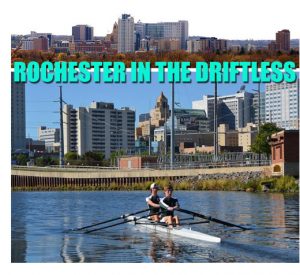Rochester, Minnesota – In The Driftless!
Rochester is a city founded in 1854 in the U.S. State of Minnesota and is the county seat of Olmsted County located on the Zumbro River’s south fork in Southeast Minnesota. It is Minnesota’s third-largest city and the largest city located outside the Minneapolis-St. Paul Metropolitan Statistical Area. As of 2015, the Rochester metropolitan area has a population of 215,884. According to the 2010 United States Census the city has a population of 106,769. The U.S. Census Bureau estimated that the 2017 population was 115,733.It is the home of the Mayo Clinic and formerly, one of IBM’s largest facilities. The city has long been rated as one of the best places to live in the United States by multiple publications such as Money.
the Zumbro River’s south fork in Southeast Minnesota. It is Minnesota’s third-largest city and the largest city located outside the Minneapolis-St. Paul Metropolitan Statistical Area. As of 2015, the Rochester metropolitan area has a population of 215,884. According to the 2010 United States Census the city has a population of 106,769. The U.S. Census Bureau estimated that the 2017 population was 115,733.It is the home of the Mayo Clinic and formerly, one of IBM’s largest facilities. The city has long been rated as one of the best places to live in the United States by multiple publications such as Money.
History
The area developed as a stagecoach stop between Saint Paul, Minnesota, and Dubuque, Iowa. When the Winona and St Peter Railroad initiated service in October 1864, it brought new residents and business opportunities further spurring growth and expansion. In 1863, Dr. William W. Mayo arrived as the examining surgeon for Union draftees in the Civil War. The community was founded by George Head and his wife Henrietta, who thought that the falls on the Zumbro River were similar to those near their old home in Rochester, New York. Rochester celebrated its sesquicentennial in 2004.
Mayo Clinic
The Mayo practice grew and is today among the largest and most well-respected medical facilities in the world. Many notable people from around the world, including former Presidents Franklin D. Roosevelt, Harry S. Truman, George H. W. Bush, Gerald Ford, and Ronald Reagan, have visited Rochester as patients of the Mayo Clinic. Rochester has also been hit by two F4 tornadoes since 1950 (the first on May 10, 1953, and the other on September 16, 1962).
Geography
Rochester lies alongside the South Fork of the Zumbro River which is 57.6 miles long and is ringed by gentle hills and largely surrounded by farmland within a deciduous forest biome. The Zumbro Watershed flows through 1,422 square miles of agricultural and urban lands. Located in southeast Minnesota, the City of Rochester falls within the Driftless Area: the only region in North America that was never glaciated and contains deeply-carved river valleys. The rugged terrain is due both to the lack of glacial deposits, or drift, and to the incision of the upper Mississippi River and its tributaries into bedrock. According to the United States Census Bureau, the city has a total area of 54.75 square miles (141.80 km2), of which 54.59 square miles (141.39 km2) of it is land and 0.16 square miles (0.41 km2) is water. The city is located 85 miles (137 km) southeast of Minneapolis-St. Paul.
Rochester is in Olmsted County, one of only four counties in Minnesota without a natural lake. Artificial lakes exist in the area, including Silver Lake, a dammed portion of the South Fork Zumbro River just below the convergence with Silver Creek near the city center. Silver Lake was once used as a cooling pond when the coal-burning power plant was operated by Rochester Public Utilities at the lake. When operational, the RPU coal plant’s heated water output prevented the lake from generally freezing over during the winter months; attracting large numbers of migrating giant Canada geese.
Rochester has an extensive parks system, the largest of which are Silver Lake and Soldiers Field in the central part of the city. A major flood in 1978 led the city to embark on an expensive and successful flood-control project that involved altering many nearby rivers and streams. The Zumbro river flowing through the center of the city is presently being readdressed for increased development and use as part of city planning in conjunction with funding from the Destination Medical Center project.
Climate
Rochester features a humid continental climate (Dfa/Dfb), with hot summers and very cold winters. The city features four distinct seasons. Rochester sees on average 30 inches (760 mm) of rainfall and 48 inches (120 cm) of snowfall per year. Significant snow accumulation is common during the winter months. Spring and fall are transitional seasons, with a general warming trend during the spring and a general cooling trend during the fall. However, it is not uncommon to see some snowfall during the early months of spring and the later months of fall. Rochester is the second windiest city in the United States, with wind speeds averaging 12.6 mph. January and April are the windiest months on average, according to The Weather Channel.
Information provided by WikiMedia Foundation in whole and in part. Link to information can be found here: https://en.wikipedia.org/wiki/Rochester,_Minnesota


